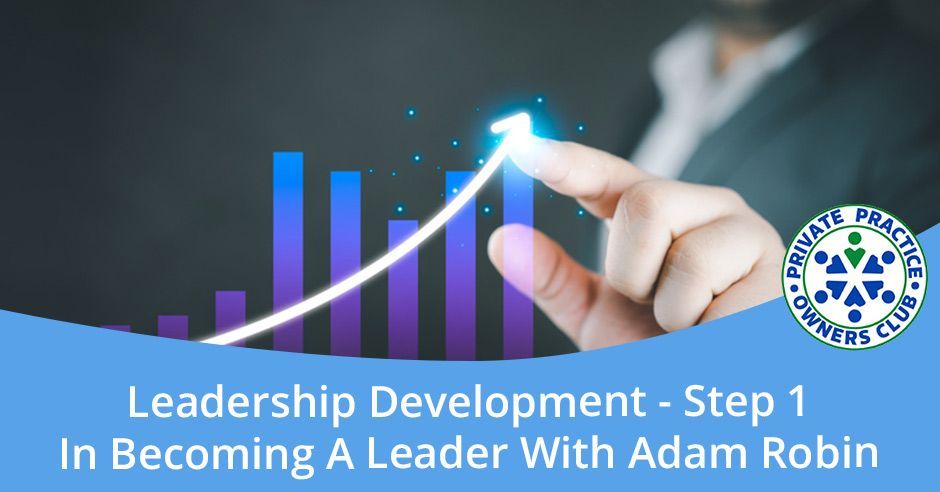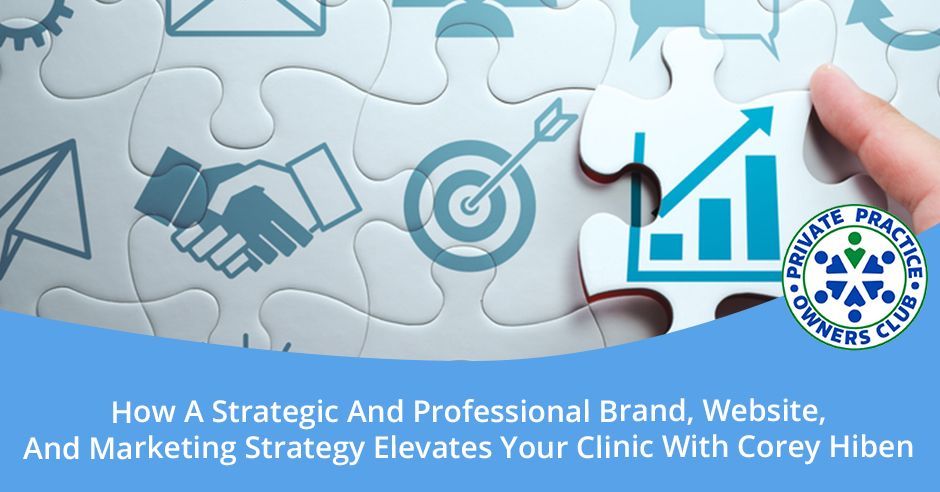Leveraging Key KPIs That Improve Production, Profit, And Retention With Eric Herman, PT Of Buffalo Rehab Group

Not all KPIs are created equal. In this episode, Eric Herman , PT, CCO of Buffalo Rehab Group , discusses some key KPIs that he uses to assess patient engagement, patient retention, and team member engagement. He explains how learning these metrics can serve as invaluable tools in assessing your clinic’s performance and making data-driven decisions. Eric emphasizes how if you have solid KPIs that reflect high engagement and retention then your clinic will be more productive, profitable, and have an amazing culture. Tune in now and learn how to take your clinic to new heights.
—
Listen to the podcast here
Leveraging Key KPIs That Improve Production, Profit, And Retention With Eric Herman, PT Of Buffalo Rehab Group
I’ve got Eric Herman, the Partner and Chief Clinical Officer of Buffalo Rehab Group in the state of New York. Eric, thanks for joining me. I appreciate it.
Thank you. It’s a pleasure to be here. Thanks for bringing me out.
I read your article in the January Impact magazine for the APTA’s PPS. I was impressed by the short article that you wrote about KPIs. I thought it was an opportunity to delve into KPIs a little bit. I’ve talked about key KPIs in the past on the show, but it’s always worth coming back around and talking about KPIs and how they lead to action for owners. It’s one thing to track KPIs, but it’s another thing to take those KPIs and know what to do next.
It’s also to help coach your team on how to be best at what they do. They feel job satisfaction also. Do your KPIs match your clinician’s values and how they want to see themselves as a clinician, too?
We’re going to get into that. I know you deal with not only patient-related KPIs but also provider engagement KPIs or team engagement KPIs. Before we get into that, tell us a little bit about you, where you’re coming from, and what got you to where you’re at.
I grew up outside of Buffalo, New York in a village called Hamburg. We’re south of Buffalo. When people look at New York State, we’re closest to the Great Lakes in that region there. I grew up there but went to a high school here and college here. My kids grew up in the same town that my wife and I did. Two of them are in college, staying local.
I did go to the University of Buffalo in New York State. I graduated with my Bachelor’s in Physical Therapy. Shortly thereafter, I began working for Buffalo Rehab Group in 2002. It’s a private physical therapy practice. When I joined, we had two offices. Since then, we’ve grown. We have 13 locations with our 14th location opening up in the Buffalo area coming up August 1st, 2023. We have a growth plan. I took over reigns as Chief Clinical Officer back in 2017. Myself and three others took over the practice from the original owners, which opened it in 1990. Since then, we’ve kept grown to over 100 clinicians and 200 total employees. We’re continuing to grow. It’s been a great journey.
It’s something to be proud of. We talked about this a little bit before I pushed Record, but that’s the first time I’ve heard of the Chief Clinical Officer role. Tell me a little bit about what a Chief Clinical Officer does maybe compared to a chief operations or anything else like that.
My main role is to ensure that our clinicians have what they need to serve our community. That’s in the form of they have the right skills and the right processes to be sure that our community is getting the extraordinary service and results that they deserve that we hope for as clinicians.
I can see in our organizational structure that it was a different title, VP of Operations. Your responsibilities were the production of the team, their engagement, but also their growth. It was almost like the quality assurance of the product to the PT, right?
Correct. A lot of what we do is continuing education. I build continuing education programs for our team. I work on our mentorship programs. That’s part of my team’s role on the clinical side. I have three regional coordinators that work with me to help coach our team to be the best clinicians. We start it with a pretty in-depth mentorship process. We teach them the KPIs that they’re responsible for.
That’s cool that you guys do that right off the bat with your onboarding. It’s very clear to me that you guys are clear about your KPIs and who’s responsible for what simply based on your description of your position as the Chief Clinical Officer. We talked about KPIs. It’s interesting simply from your conversation or explanation of how you onboard your new employees. You guys are KPI-driven or stat-driven with objective data to determine how well you’re doing. Many organizations, mine included, when we were young, it was, “The numbers are right. I’ve hit my new patient goal. I’ve hit my total visit goal. My bank account looks good.” Those were my KPI drivers.
This has evolved a lot over the years. We work with an advisory group ourselves. Steve Stalzer was on a couple of times with you and Mike Osler. I work a ton with Mike Osler. We meet on a regular basis at 8150. It is similar to having the ability to continue to how we can keep making this better. With that, we evolve a way to measure what we do and find success behind it. Also, we get the conversation to a point where we’re able to explain why this matters for the clinician, the patient, and our community members.
That’s the key to it. Nobody wants to hear about their stats or their data, so we talk about it towards the feeling side of it. It makes the individual feel these data points that these KPIs will help them be the best clinician for their patients. That’s ultimately why we get into the profession. It is to help people and get people to achieve their goals. Once you can relate these KPIs and some of our sub-KPIs, we clearly show the clinician, “You’re hitting these marks and when you’re hitting these marks, we know you’re delivering great care. That’s why these marks exist.”
The reason why we ultimately get into the care profession is to help people achieve their goals.
Click To Tweet
I love that you brought that up because there are some of those owners that maybe haven’t been tracking KPIs, then they implement some KPI or stat tracking program. You can understand or maybe predict that some team members are going to say, “You guys are all about the numbers. I don’t know why we’re all doing this. Everything was fine.”
Kudos to you guys that you’re doing from the very beginning and not trying to implement it later. KPIs are simply objective data that tell us, 1) Are we providing the care that we say we’re going to provide? 2) Are the patients getting the results that we say they’re going to get? 3) Are we being efficient? Are we being with our time? A lot of team members might not know the low level of efficiency that physical therapy provides to the communities around them. When you see that only 15% or 8% of people complete their full plans of care, we’re not doing a good job at that time as an industry no matter how good we feel about what we’re providing.
As a clinician, you look at it as, “My patients are happy. I know my patients are happy.” What you’re getting is people are discharging. The ones that discharge in front of you face-to-face are going to be lifelong evangelists for you or lifelong friends for you. You see them at the farmer’s market or the grocery store and they’re going to want to give you a hug. The number I’ve seen is 30% of people complete the plan of care.
Whatever it is, it’s horrible.
It’s awful. As high as 25% of patients make it to drop out before three visits or something like that is incredible to me. What can we do to help our patients get to their end? We start looking at the right pieces to know, “How many people am I getting to the finish line?” It’s not that we’re trying to point a finger at a clinician like, “You’re not doing a great job.” It’s, “How can we help you get your patients to the finish line?” We need it as a profession, let alone as a business, and then as an individual and a clinician. Keeping a patient on track to meet their goals, our profession needs that.
I’m glad we’re talking about it. It helps us determine how well we’re doing as far as living out our purpose as a clinic. That objective data though can come back and tell us how well the provider is doing on an individual basis which is a 1B to the 1A behind the purpose of finding out the stats of the individual providers. Ultimately, you’re going to have to have some employee review. They’re going to want a raise. They’re going to want bonuses. What do we base that on? We don’t base that on off of good feelings. It’s always helpful to have some objective data to help you with that.
WebPT came out not that long ago that 30% of patients complete their plan cares. Of the ones that complete their plan cares, it was 17.3% visits pre-evaluation. That’s astounding to me because those are not numbers that we see with a profession. When I went to PT school decades ago, we were taught the sooner that we get the patient out our door, the better clinician we are. That was explaining why our visits per new, we call it commitment to care, why our commitment to care was so low.
We’re trying to explain our data like, “My average is six. That means I’m a great clinician compared to the person that’s seventeen.” You got to think of all those cases that are like, “You have chronic pain? That doesn’t happen in six visits.” We try to coach our patients, clinicians, PTs, and OTs that a lot of the patients that we see have had prolonged issues is going to take them longer. We see the best value somewhere around that 10 to 12-week mark. That’s for a typical patient. We use outcomes tools as one of our KPIs. We see that the best results come if a community member has been with us for around that 10 to 12-week mark.
10 to 12 weeks, not 10 to 12 visits?
It’s not 10 to 12 visits but 10 to 12 weeks.
It is more than 10 to 12 visits.
Most of the time, yes. That leads to the seventeen visits making sense. We like to see our commitment to care number to be sixteen visits as our goal. Our productivity and performance bonuses are on that fourteen-visit mark. We’re getting our clinicians to where we would expect that we’re shooting for a complete plan of care. That’s a large data group that our PT uses. It is 17.3% for those that complete plan of cares. Let’s complete plan of cares.
You pointed out four specific metrics in the article. One of them was decreasing patient engagement. Is that your average number of visits per new patient? Is that your metric for patient engagement?
With the patient engagement scores we use, we coach our clinicians as to how many encounters during their plan of care journey their patients need to get the best outcomes. Talking to them is the feeling behind it.
Remind me. Is that your key stat as the Chief Clinical Officer that you’re responsible for?
Correct. Those are visits per evaluation, visits per new, or what we refer to in our team as the commitment to care. My goal for our clinicians is to get them to sixteen.
It was interesting before we started the interview here that you were talking about your personal or your position KPI. You have a key KPI. I love that you said you have sub-KPIs. If you’re clear about the KPIs, there are typically primary KPIs, and then there are KPIs that individually will improve the key KPI. It’s hard to say all KPIs are the same. There should be one lead KPI for each position in the organization, but there are sub-KPIs that will improve that key KPI and tell you how well they’re doing.
It’s the idea of lead indicators versus lag measures. With the commitment to care, our number happens after someone’s discharged. We need something that we can look at in real-time that will drive the processes toward getting a great result for that lag measure.
Give us a couple of examples of your sub-KPIs that lead to an improved number of visits per evaluation, which is your key KPI.
The main one that we look at with our clinicians is the days scheduled at evaluation. How many days out did you schedule? We know that the best results happen or the best outcome changes happen at that 8 to 12-week mark. If we’re scheduling out two weeks at our evaluation and that’s our average, we’re not setting the right expectations for the patient.
We may be telling them, “This is going to be about seven weeks before you’re feeling like you can do your day-to-day tasks. It’s going to be twelve weeks before you feel strong enough to do the things you really want to do. For the backyard skills like raking, shoveling, or carrying mulch bags, for what we’re seeing you here for with this back injury, we’re probably looking at twelve weeks of care and progressions before we get you to the finish line you want. How does that sound?” That makes sense based on strength gains. You go through that whole conversation with a patient and then you’re going to schedule three visits in the next two weeks? That doesn’t make sense.
My goal with my patients in front of me is this. I look at it as almost separating out into four phases of care. When I’m treating a patient, I talk to them about four phases of care. The first phase is a protective phase or a pain control phase where I want to create a new environment for the patient. That takes about three weeks. I want to see you twice a week during those three weeks. The second phase is the mobility phase. I’m going to see you once a week for this phase. It’s going to take us three weeks to get through this phase. Once we get the stability, it’s another three weeks. I’m trying to schedule through that third phase on that first visit. It’s giving me nine weeks of care setup.
I’m scheduling the expected number of visits that I need to see that person for in each phase based on their condition. If someone has resources coming in and they’re fit and active, I may not need to see them as much in that mobility phase or the stability phase. Having that full education to a patient, our KPI of looking at the number of calendar days scheduled at evaluation is key to knowing that our clinicians are providing the right information and then following up with the action of scheduling it. That’s our main sub-KPI.
I love what you’re doing there because you’re using visits scheduled at evaluation or calendar days scheduled out, which I haven’t heard of before. That’s interesting. Nonetheless, you’re using that as a lead indicator. That is what it sounds like. It is a lag indicator, but you are using the lag indicator to predict how things are going to look in the future.
The nice thing about it is that you’re getting your patients on s schedule. You’re setting up the expectation for the patient. I can look at a clinician who uses business intelligence that populates as one of the things that we look at on a daily and weekly basis depending on who the clinician is. It is to know what your average calendar day schedule is at your evaluation.
You’re right. In a way, we still measure because it’s a behavior that our clinician made at the evaluation, but then, it’s a past thing. Our clinicians know that we are looking at it and that we are going to educate them on it. We tell them why it’s so important and critical for them to complete plan of cares. As a clinician, with every patient that walks in the door, we want them to have this successful outcome.
As a clinician, we all want every patient that walks in the door to have a successful outcome.
Click To Tweet
We didn’t come up with this until the last couple of years. It was in 2017. It has been four years before it was like, “Is this the thing we need to be looking at?” We find that the clinicians that not only educate the patient but then do the active scheduling and creating this timeline for a patient, we’re going to be successful in this 52 days or 56 days. If I said to a patient, “We’re going to be successful in fourteen days,” that’s not going to get the results that our patient wants.
That’s unethical. What kind of magic lotions do you have? That’s one example. I’m sure you’ve got a few different metrics that lead to that patient engagement completion of care statistic. Maybe there isn’t a KPI specifically for this, but you also train your providers on teaching that plan of care to your patients.
We call it whiteboard wisdom.
Is there a KPI associated with that?
This is a new clinician for Buffalo Rehab Group. When someone has worked somewhere else for three years and they come to us, part of their mentorship is that they’re working with their office leader as a mentor. They go through and look at the whiteboard wisdom that the provider has done for their patients. We have tear-off sheets that our providers fill out, or they take a snapshot or a picture of the actual whiteboard when they’re done educating their patients.
They’re showing the patient, “This is the tissue that’s involved. These are activities that you’re telling me that you’re limited on. This is the timeline that we expect these activities to be better on. This is the number of visits in each phase of care you’re going to need.” All that information is there. We’re looking, for our newer clinicians with us, that they’ve done that education. They do prove that they’ve done it by their office leaders being able to see that this was done.
I love that you call it whiteboard wisdom. We can all picture what that means. Maybe not every treatment room has a whiteboard, but you can imagine a physical therapist standing at the whiteboard after the initial evaluation saying, “This is my plan for you. Here’s the tissue involved. This is how we’re going to attack it. Here is the timeline for it.” They write that all out. Some people are very visual. I love that you guys are doing that because I never did that. Why not? Some people are better visual learners than auditory learners. Why not for both? You can get buy-in.
We used to have small whiteboards in all of our exam rooms. Our CEO, Jeff Woodrich, is the one that did the term whiteboard wisdom for us. He and our Chief Marketing Officer, Steve Gonser, which is one of my other business partners, their mission was to get a whiteboard in every single evaluation room. We have whiteboards in every evaluation room. We have whiteboards in the clinic.
I’m constantly writing up a patient in the clinic like, “This is the next programming you’re doing. This is the phase we’re in now. Let’s reference this.” I have patients take pictures of their whiteboard wisdom at their evaluation. I tell them, “Hold me to this number of days.” When I’m telling them that this is a four-month process to get back from their knee injury to be 100% back, I’m like, “It’s going to be a four-month process, and it’s going to be this number of visits. Hold me accountable to these numbers. I want to know that I’m behind on this track that I’ve promised you.”
You can see that the whiteboard wisdom and the training on that, although it might not have a specific KPI, it’s going to be checked off on the onboarding checklist that they’ve shown competence in that. That’s going to lead them to a KPI that you can measure, which is the number of total days scheduled in that initial evaluation. If that’s meeting the mark, then you are getting to the 14, 16, or 17 visits per new patient metric that you want. You can see how that all flows together.
The cool part is it does match other pieces of our business where we have phone calls every day for new evaluations. If I’m not scheduled and my patient is out, there looks like there’s a spot for evaluation. If I haven’t scheduled my patients two weeks out and then all of a sudden, evaluations start popping up on my schedule because I’m not scheduled out properly, whose fault is that? That’s mine as a clinician that I didn’t manage my schedule well. I didn’t manage my current caseload well. I have more evaluations on my schedule that I don’t have space for.
I love how you can also buy that method. If that end KPI is decreasing, you know where to look backward to see where the ball was dropped. What is that statistic for calendar days scheduled at the initial evaluation? If that’s lower, why? Did they do the training? What did they do to the whiteboard wisdom training, to begin with? I know you have many directions that you could go off of that. You could be looking at arrival rates and other things like that. Why not?
The number one thing is that if a patient is not going to arrive, they’re not on the schedule. We do look at arrival rates, but we don’t lean on arrival rates. What we don’t want is for patients to not be scheduled for their plan of care. There’s no way they’re going to meet their plan of care if they’re not scheduled for it. That is another one of the sub-KPIs that we do look at as arrival rates. We don’t coach like, “You need patients to show up to their visits.” We coach them on the processes that will get patients to show up to their visits.
There you go. You’re focusing on the front-end stuff. Did you sell the plan of care, to begin with? Let’s start there. Did we talk to them about the cancellation policy? Maybe the cancellation fee, if you use that or not, we talked about that all at the front end. If you have prepared all that at the front end, then the arrival rate you’d imagine should be relatively good if you did all those things properly. You also talked about some other KPIs. The other one is, and you alluded to it, the patient satisfaction. That’s where you use NPS or the Net Promoter Score.
This is interesting for us. Do we care about our net promoter score that it’s above 90%? Yes, for sure. It is, but more important is that we have patients that are telling us how we’re doing. Our entire team’s performance bonus monthly is based on that more than 45% of our patients are responding to the number of evals. It’s a response rate. Typically, above 60% of our patients are telling us how we’re doing on a monthly basis.

These are responses to phone calls, texts, or emails. What are the responses?
We use PT Wired. We use their patient engagement. Vik was on. It was at the end of May 2023.
It was a couple of episodes ago.
We use PT Wired. They have an NPS part of that. That gets pushed to our patients after 6 days and then after 30 days. We can also manually send it to a patient, too. If a patient’s telling us about their experience in the clinic, we’ll stop and say, “I’m going to send you our NPS score. Let us know how you’re doing. You seem to be pretty satisfied. I’m going to push this to your phone.” We automatically send it, and then they let us know. Our clinicians are trained to educate our patients that they’ll be getting an NPS survey on, “How likely are you to refer a family or a friend to Buffalo Rehab Group from 0 to 10?”
It’s a one-question survey.
They hit the button and it’s done. Our providers can be like, “It looks like I haven’t gotten one from you yet. Do you mind if I send a survey to let my team know how well we’re doing for your experience?” That manual send change that they have with PT Wired has helped out a lot. We’re typically above 60% of response rates. It’s great that our whole team is involved. Everybody in Buffalo Rehab Group will get a monthly incentive if our entire team is above that 45% response rate.
Your responses then come through the app, or does the app then push the text or something like that?
It pushes an email to the patient. They can go and click the email and it goes right to the app.
For those people who don’t have apps, how would I do that? You’re talking maybe about an email campaign, but more importantly, the provider at the moment when the patient is effusive about your care, you’re saying, “Do you mind if you have you take a one-question survey to tell us how we’re doing? Do you mind?” You don’t have to have the PT Wired app to do that. It’s very efficient and helpful to have that, but if you don’t, you can always use an email.
There are a lot of ways to measure. Reaching through a PT has one also.
To go back to the previous KPI of patient engagement and patient satisfaction, do you have a sub-KPI for that like the number of emails that go out or anything like that? I’m wondering if there are some other KPIs related to it like the previous KPI.
Yes. For us, we do. It’s through PT Wired. If you’re not putting a patient in PT Wired, you can’t send them an NPS score. You have to set them up with the exercise program in PT Wired in order to get there. That also helps us out at getting more of our clinicians by using PT Wired. The goal is every month, all of us are responsible for getting those NPS scores. That’s our way to use our digital home access program, too.
There is a sub-KPI of the percentage of your new patients that are signed into PT Wired.
Exactly.
You could say how many of your patients do you have emails for? You can’t send this out if you don’t have their email address.
That’s what it previously was. In order to set them up on PT Wired, you need their email address. That’s in there, too.
You are the CCO. You’re responsible for patient engagement and patient satisfaction. You’re also responsible for the team member satisfaction, not just PTs. Is this the entire business team’s satisfaction or the providers that you’re responsible for?
We have another division or people in the culture division that’s responsible for our overall team engagement. Our clinical staff sees engagement. I know that was part of the article.
That’s not necessarily under your department.
That’s not under my umbrella.
Nevertheless, a key indicator.
Certainly. We meet with our people and culture team on a weekly basis. One of the things we do discuss and talk about is our clinician retention. We’re at 95% clinician retention. We do pretty well, so it’s awesome. Part of my role is also clinical education. We call it our lifelong learning division. We build our own continuing education, but then we also provide a stipend for it. Part of our team engagement is our clinicians using their stipends and our clinicians going to our clinical education events.

That’s where my team and the people in culture team work together. We create these events with who’s going to them and which of our clinicians are engaged in learning some of the new things that we’re doing and the new technology we’re bringing. That’s where we will work with each other. We start to notice that this set of clinicians isn’t coming to the events that the clinical team is putting on. We’re having our people and culture team target those individuals with meetings on, “How can we help you extend your career?”
A lot of conversations are between departments. We know the engagement of each individual. We go to happy hours. They’re highly motivated to go to the happy hours. We had a running event. Some of the clinicians that I don’t see at our clinical events were at that running event. They’re engaged with our company. I have to figure out what’s going to get their juices flowing clinically to continue to improve themselves as a clinician.
You’re measuring. You might not have a clear number set, but you are measuring, in a way, their engagement via their attendance to onsite training, clinical education training of their own choosing, or the parties and activities that you do as a group. You’re somewhat measuring those or at least trying to figure out who’s dropping off where and how can we address them.
The people and culture team is. They have a spreadsheet.
They have the KPIs and all that for team engagement. That’s interesting. We used to do an NPS score not only for our patients but also for our team members. Once or twice a year, we’d give them the NPS score. We’re like, “How likely would you refer family or friends to become an employee in our organization?” We pride ourselves on a high NPS score for team engagement.
I like what you’re talking about as well as who’s taking advantage of the continuing education because you want to see them improving professionally so that they have some job satisfaction in their technical skills but also who’s engaging in the parties, the runs, and the charity events that you guys are doing so they can also get a little bit fulfillment outside of that.
We do Gallup surveys twice a year with our team. We also have another survey the other quarter. Quarterly, there’s some engagement survey. You described the NPS. We do have that also, but not my division. It wasn’t top of my mind.
I’m sure you get the survey yourself.
I get the survey and I do answer it every quarter.
Is it a number of questions? Are they questions that you came up with yourselves or did you research and find a patient engagement questionnaire that’s out there?
It’s ever-adapting and changing.
You guys create it.
I don’t know where they’re getting the questions from. I know the last one I answered was different from the previous one slightly, so there are slight modifications.
It’s not the same every time. That’s interesting. That’s cool to know. For the last KPI, you talked about your financial division and assessing for financial stability. I know that’s not your department. Nevertheless, there are some leading and lag indicators that you might want to follow and be on top of if you’re going to make sure that the lifeblood of your company is still flowing.
Our clinical team works with our billing team is we meet with them biweekly at this point to go through what processes we need to slightly adjust to make sure that our billers are getting the right information from our clinicians. We look at our procedure codes. We call it the abundance of care and diversity of care. That’s mainly where my team is responsible for providing our clinicians the right amount of time to work with their patients whenever they want to. That’s a measurement of the abundance of care.
We would anticipate that the majority of our patients are getting three procedure codes. We don’t mandate any codes, but we would anticipate that we should have somewhere around 30 to 40 minutes of direct one-to-one care with each patient. We shouldn’t see much more than that, and we shouldn’t see much under that. If our team isn’t providing that amount of time with the patient, our billing department is going to say, “There is something going on over here.” That’s one of the KPIs that we measure.
Diversity of care is that we’re utilizing our full skillset and practicing at the top of our license. We’re using therapeutic activities, neuromuscular education, and TherEx manuals. We’re using a variety of codes for each treatment. We shouldn’t see a therapeutic activity times three. We shouldn’t see a TherEx times three. Practicing on top of a license means that we’re using all of our different skills. We coach our clinicians on that, too.
Our billing team is going to turn around and say, “We’re noticing that these visits don’t seem to have the same coding that we would expect.” When we look at their schedules, are they overscheduling themselves, undercoding, or undervaluing their care? That has been the termination that we go back and forth yet. Our billing team has its own specific KPIs. They look at arc ratios. They also have processes that they follow daily and weekly to make sure that things are flowing through our clearinghouse the right way. They talk about it, but I don’t fully understand it.
You let the CFO figure that out, right?
That’s right.
I love the thoughtfulness that you put into both the abundance of care and the diversity of care issues. That’s one thing where simply the semantics of it gives a better representation of what is expected versus, “When we bill three TherEx and one manual, we’re not going to get paid as much as we will if we use multiple codes. We’re also not subject to MPPR reductions if we use multiple codes multiple times. Let’s diversify our care, number one. Also, let’s teach you how to document for a diversity of care and which exercises might be more appropriately billed as therapeutic activities versus neuromuscular reeducation.” I don’t know anything about your organization, but I’m pretty certain in saying that you’re teaching that to them under diversity of care.
In diversity of care, we’re coaching them on what each code represents and means. As clinicians, we don’t bill. We don’t submit our charges. That’s not what we do as clinicians. We provide care and then code the care we provide. That’s how we coach our clinicians. The charge happens when it gets to our billing team. We’re writing the code down as the procedure we performed, and then it goes to our billing department. They’re the ones that press the button for billing.

All we coach our clinicians on is, “These are the skills you use. These are the processes you use with the patient. This is the education you provide to the patient. When you do this type of procedure, that’s this code.” You are educating them on the codes themselves and documenting and coding what you performed in the clinic. It’s then moved over to the billing department to submit the charge.
The important thing to recognize there and what you guys did recognize, and what we’ve all seen is that we don’t learn these things in physical therapy school. We don’t learn what the codes mean in physical therapy. We don’t learn them in our internships. The fact that you guys take it to another level, anyone who’s going to join Buffalo Rehab Group is going to get good training on exactly what the CPT code says and how to best utilize it in what circumstances.
I didn’t understand it until being educated by Robbie Leonard at 8150 Advisors. That was a few years back. The light bulbs went off like, “Now I get it.” I practiced for almost twenty years without having a full appreciation for what it was and what it meant. That was eye-opening to me for me to continue to learn at that rate after being involved with it for as long as it was.
What does it say about the clinician that has been with us for only five years or is new to us? That was pretty powerful to me. I was like, “We have to find a way to educate our team on what this means.” We pushed hard. It was during COVID that we took time to educate our team on what the procedure codes mean and what diversity of care is.

It’s cool to hear that you took advantage of the time that you had there. Is it safe to say that maybe your profit margins improved a little bit as you focused on the diversity of care and abundance of care?
We were undercoding the procedures we were performing. The biggest piece of it, from what I learned from working with Robbie, was that our education about why our treatments are clinically relevant for that individual is the teaching aspect of it. I wasn’t coding that at all. I was coding the actual moments. I was doing something but not coding the time that I spent assessing why I would do it. Part of the code is an assessment of why this next treatment that I’m going to do is important.
I was maybe coding my corrections and the act of doing the move, like a lunge. It’s not what led me to decide the lunge, but watching them walk and noticing they don’t have the right kind of hip extension. I chose a lunge because of that, and then I reassessed the walking. All of that is supposed to be, at the time, coded, performing that lunge. I was not aware of that.
I appreciate how you guys have looked at these in silos. As you’ve done all these things, not only, in the end, has it improved overall revenues but also, in net profits, increased patient engagement, provider engagement, and patient satisfaction. As you do all these things and put them together, what’s good for the patients and for the providers is best for the business.
This is where it goes all the way back to what we started with. It’s plan of cares. We complete plan of cares. That means our patients are satisfied because they’re sticking around with us long enough to complete it. Our clinicians are seeing more of their patients earn successful outcomes, which leads to more job satisfaction. If we’re using our time with the patient effectively by providing an abundance of care and a diversity of care, we’re going to see better outcomes. That is then going to trickle down to patients wanting to keep coming because they’re getting successful results and getting the time they need and deserve.
If we're using our time with the patient effectively by providing an abundance of care and a diversity of care, we're going to see better outcomes.
Click To Tweet
In being the Chief Clinical Officer, I’m glad I look at it this way. If we complete plan of cares or we get people to complete them and coach them to complete them, our business is good. Every patient is getting the outcomes they want, need, and deserve. If our clinicians are seeing it to the end, they’re going to be more satisfied, too.
You built appropriately along the way.
That’s good for business.
You’re not giving away free services. That’s always good. That keeps you alive.
It’s great for business.
Is there anything else you want to share about some of the leading lagging indicators, KPIs, you name it, that maybe we didn’t touch on?
Our journey has been a constant evolution, and it continues to be so. Keep learning and don’t get stuck on one. Keep asking the question why. We used to look not too long ago at a 3-week retention rate, 6-week retention rate, or 9-week retention rate the percentage of patients dropping off in each of those timelines. That was cool to look at. It was great to look at.
We found out that we should see that 80% of our patients are still engaged at 3 weeks and that 60% of our patients are still engaged at 6 weeks. We should see that 40% of our patients are still engaged at 9 weeks. When we take people through their journey, we were seeing that. That was a neat KPI to look at. You get a chance of which providers are maybe seeing their drop-off happen at that 4 to 6-week bucket.
You then get a chance to educate the patient on how their programming needed to change in that set. We needed to advance our care a little bit quicker. The patient got bored with the care because you weren’t challenging them at a high enough level. We found that that’s a 4 to 6-week if someone’s fallen off in that range. We wouldn’t know that if we didn’t measure it.
If we talk about too many KPIs, then those who are reading that are maybe not tracking KPIs could get seemingly overwhelmed.
That’s where we got to the one.
Bring it back to one main one.
For our team, we found days scheduled for evaluation were the driver of everything else.
Look backward and forward at the same time based on that. I love that.
That’s something you can look at on a weekly basis. If you have 6 evaluations in the week, what’s your average for those 6 patients that you scheduled out? It’s not too cumbersome to see that. EMRs can easily find that information.
If people wanted to reach out to you or learn more about Buffalo Rehab Group, how would they do that?
My email is the best way. It’s Eric@BuffaloRehab.com.
Are you on the social media platforms at all?
I am. I’m new to it, so I’m more of a watcher. I do want to get involved, but I always find that there’s so much great stuff out there. I get entrenched in a lot of different things.
You haven’t developed your TikTok channel yet, it sounds like.
I have not. My kids are into that stuff. My daughter sent me one. I’m a huge hockey fan. The MVP of the team was a golden retriever that gave high paws to the players. They went on and on off the ice. She figured that that would be a good one for me to look at. That was the TikTok I got.
That’s funny. Thanks for joining me. I really appreciate it. I’m sure we’ll get in touch with you some other time.
That sounds great. Thanks for your time. I appreciate it.
Thank you.
Important Links
- Buffalo Rehab Group
- Steve Stalzer – Past Episode
- 8150 Advisors
- Vikram Sethuraman – Past Episode
- Eric@BuffaloRehab.com
About Eric Herman
 Eric Herman, Chief Clinical Officer of Buffalo Rehab Group, Physical Therapist, and Fellow of Applied Functional Science graduated from the University at Buffalo in 2000 and began working for Buffalo Rehab Group in 2002.
Eric Herman, Chief Clinical Officer of Buffalo Rehab Group, Physical Therapist, and Fellow of Applied Functional Science graduated from the University at Buffalo in 2000 and began working for Buffalo Rehab Group in 2002.
Eric has served as Chief Clinical Officer of Buffalo Rehab Group since 2017 and heads clinician skill development and strategy initiatives for the company. These initiatives create an environment for lifelong learning and ensure Buffalo Rehab Group’s mission is a commitment to providing exceptional results and an extraordinary experience to the community to restore their quality of life.
Buffalo Rehab Group provides Physical Therapy and Occupational Therapy services in Buffalo, NY with over 100 clinicians at 13, soon to be 14 locations. As CCO Eric is dedicated to BRG’s purpose to “Help our patients get their lives back” and upholding our Core Values of: “Honesty Community, Flexibility,
Service, Learning, Innovation, Inspiration, and Growth” assisting our clinical team to becoming the best versions of themselves professionally and personally.
Love the show? Subscribe, rate, review, and share! https://ptoclub.com/












